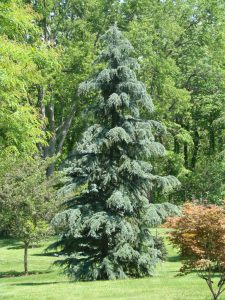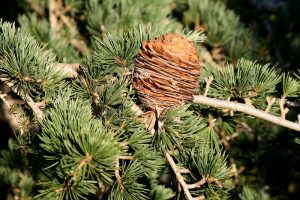Deodar Cedar
Deodar cedar, sometimes referred to as the California Christmas tree, is a speciesof conifer occurring in the western Himalayas at an altitude of around 1,500 to 3,200 m.The tree is graceful with pendulous branches and comes in attractive coloring, ideally suited for use in landscaping.
Scientific Classification
| Kingdom | Plantae |
| Division | Pinophyta |
| Class | Pinopsida |
| Order | Pinales |
| Family | Pinaceae |
| Genus | Cedrus |
| Scientific Name | Cedrus deodara |
Quick Information
| Other Names | Himalayan Cedar, Deodar, Devadar, Devdar, Devadaru |
| Size | 40 – 50 m in height, rarely 60 m; trunk diameter up to 3 m |
| Leaves | Slender, needle-shaped, 2.5–5 cm long, rarely up to 7 cm; appears singly on long shoots and in clusters of 20 to 30 on short shoots;bright green to glaucous blue-green in color |
| Cones | Female cones: Barrel-shaped, 7 – 13 cm long, 5 – 9 cm broad Male cones: 4 – 6 cm long |
| Tree Type | Evergreen |
| Shape at Maturity | Pyramidal, conical crown |
| Distribution/Range | Eastern Afghanistan, northern Pakistan, India (Jammu and Kashmir, Himachal Pradesh, Sikkim, Uttarakhand, Darjeeling in West Bengal), south westernmost Tibet, western Nepal |
| Hardiness Zones | 7 – 9 |
| Lifespan | Can live 1000 years |
| Growth Rate | Medium; annual height increase is 13 – 24 in |
| Growing Conditions | Temperature: Trees tend to die in temperatures below−25 °C (−13 °F) Water Requirement: Tolerates drought well Sunlight:Requires full sun Soil Requirement: Prefers moist, acidic, loamy, sandy, clay and well-drained soils |
| Flowering/Fruiting | October – November; monoecious; produces flowers less frequently in comparison to other cedars; pollens are shed in Autumn |
| Seed Production | Commercial seed bearing starts from 30 to 45 years of age; female cones mature in 12 months and disintegrate on attaining maturity to shed the seeds |
| Problems/Diseases/Pests | Vulnerable to honey fungi, root rot, tip blight |
| Wildlife Value | Provides nesting sites, food, and cover for mammals and birds |
| Cultivars/Varieties | There are numerous cultivars including Argentea, Golden Deodar Cedar,Karl Fuchs, Feelin Blue, Sanders Blue,Feelin Sunny, Weeping Deodar Cedar, Kashmir,AureaPendula, Blue Dwarf, Blue Mountain Broom, Pygmy |
| Uses | Inner wood is used in making incense and essential oils;good source of timber especially as a building material; earlier used for construction of barracks, bridges, public buildings, railway cars, and canals; used as an ornamental tree, living Christmas trees, and bonsai |
| IUCN Conservation Status | Least Concern |
Interesting Facts
- The tree has a unique branching pattern, with its wood being stronger than most other conifers.
- Cedar oil has aromatic properties and is used in aromatherapy while its antifungal properties are beneficial for storing food in rooms built with cedar wood. The stem and outer bark of the tree has astringent properties.
- The essential oil from deodar cedar is used as an insect repellent on the feet of horses, camels, and cattle.The crude oil, on the other hand,is used in making floor polishes, soap perfumes, household sprays and insecticides.
- The tree has earned the Royal Horticultural Society’s Award of Garden Merit.
- It is Pakistan’s national tree.
- In ancient Indian culture, the deodar forests were regarded as a sacred place where sages used to meditate. InHimachal Pradesh, people with asthma and other respiratory trouble are now recommended to sit under this tree early in the morning.
References:
Published on December 14th 2016 by Sajal Datta under Cedar.
Article was last reviewed on 9th May 2023.












